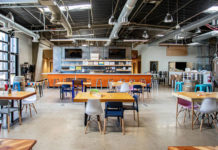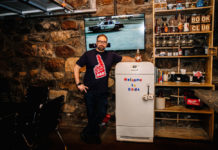Music is, by far, one of the most important components of any successful bar or club. Whether inspiring all-night dance parties in the hottest nightclub, prompting intoxicated sing-a-longs in a local tavern, or providing soothing background ambience for conversational crowds, the right (or wrong) music can make (or break) a great night in your bar, and even affect its overall success as an establishment.
And it’s not just the song selections that make the difference; that can be honed over time by the crowd of regulars who demand certain genres, be it on the jukebox, by your live acts, or from your DJs. (Incorporating the Top 5 Song list from each Tuning Up column in Bar Business Magazine is an advisable first step.)
But the bottom line is this: you could discover a set list of music discovered in the Lost Ark of the Covenant that is guaranteed to evoke eternal euphoria for anyone who hears it, and if you play those songs through a sub-par sound system, you’re not going to see the advertised results. To create the best audio experience for your patrons—and therefore give them a reason to continue spending money in your club—owners need to have the optimal sound system for their location, based on certain criteria for their physical venue, crowd, and musical styles.
Whether installing a completely new sound system or overhauling and improving your current system, there are several important steps and things to consider.
DON’T BE A HERO
Like many home-improvement ventures, who amongst us isn’t tempted to save a few bucks in the budget by taking the do-it-yourself route. Only when a pipe bursts thorough the floor flooding the basement or the new countertop doesn’t quite seem level do we finally submit and call a contractor. Simply put, self-installation of a new sound system is the most common misstep club owners can take.
“The single biggest mistake I’ve seen in my 30 years, that I see over and over, is an attempt by owners to either install a system themselves or have a friend who knows car stereos do it for them, and they go online and buy a speaker because that particular Web site has it on sale this week, etc.,” says Kurt Kieslich, National System Design Specialist at Sound Stage Systems in North Haven, Connecticut. “The bottom line is, they’re tripping over dimes getting to the dollars. A licensed sound contractor is a true profession. I mean, you have to be licensed just to pull speaker wire in most states.”
Bar owners, adds Kieslich, have plenty of things to worry about without focusing on the intricate and technological details of their sound systems. “They have to be concerned with how their cash is coming in, if their liquor is being sold, etc. These are things that an owner has more control over in his world. For him to try to become a sound guy, I think that’s time that can be used wisely elsewhere. He should be more concerned with finding an integrator who has a lot of experience in his type of venue.”
In addition to Kieslich and the Sound Stage Systems crew, audio integrators can be found through hundreds of similar sound & lighting companies around the country. As a bar owner, you should seek out, research and contact a licensed sound contractor in your area at the very beginning of your design process.
KNOW WHAT YOU’LL NEED
Whether you own a tiny tavern or a cavernous club (and if you can’t decide, see “Does Size Matter?” on page 42) you need to know what kind of sound you’ll want to generate. In addition to the physical layout of a club (ceiling height is very important), the source(s) of music is key. Will there be live music? Live DJ? Jukebox? iPod? All or some of the above? According to Kieslich, bar owners should think of it this way: “If you’re even thinking there’s a possibility you’re going to do music type X, then you probably will, so you have to prepare for it now.”
Metro Sound Pros Inc., in Washingtonville, New York has been designing and installing sound, lighting, and video systems since 1994. They provide bar owners who come to them for consultation with a standard form to fill out, which provides them with all the vital statistics that will enable them to best supply and install a club’s sound system.
Likewise, Sound Stage Systems discusses with club owners what they will be doing with their space before going forward with a system design. “During the initial interview, we’re going to find out what his venue’s music format is,” says Kieslich. “Oftentimes, someone will say ‘We just want background sound,’ and then within the first month they realize they don’t want their customers leaving at 11:00 p.m., and now they want to turn up the system loud enough to play dance music. So what we try to do is feel things out to see if they’re going to go that way, because the kind of system we would set up for just background music is not going to be capable of producing dance music levels.
“Essentially, we engineer the system for the loudest format that they’re going to be using. At the highest end, if you engineer a system for a live band, you can always work down from that, in terms of plugging in an iPod, playing a jukebox, running your TV through it for Sunday sports, or having a DJ in, etc. But it’s not vice versa. You’re not going to install a background music system that you might find in a local restaurant and be able to run a band or a DJ through it.”
Kieslich is quick to point out that, should live DJ music be a source of entertainment for your club, it’s wise to prepare for all of the various formats in which music comes these days. “Five years ago, your DJ was bringing in six cases of CDs, and five years before that he was bringing in milk crates full of records, and now he may show up with a laptop computer or iPods,” he says. “And we find that all of those DJs still exist, so you may one night hire an old-school ‘rockstar’ DJ as we call him, and he may come in and spin vinyl; another night a DJ may bring in his laptop, etc. So you have to be prepared to handle all the formats, whether it’s iPod, CD, laptop or even turntables.”
START PLANNING YOUR
SOUND EARLY
The do-it-yourself faux pas may be the most common mistake bar owners make when planning their sound system, but the second sin many proprietors commit is sloth: waiting too long to plan out the system. “We get calls from people after their walls are all closed up and the tiles are all down, and they say ‘Ok, we’re ready to go on the sound system,’” says Kieslich. “Then we explain that we have to run wires throughout their entire venue with everything all closed up already, and now the labor cost has changed for them, in a bad way. So getting started early is your best bet.”
Essentially, sound is an aspect of any club that needs to be addressed from the very first moment, along with the most basic architecture blueprints and interior design. Wiring, speaker placement, amplifier and hardware storage—all of these things need to be considered and drawn into a club’s original specs to make the process most cost-effective for the owner. Once walls and ceilings and floors are built and filled in, the installation becomes much more difficult.
“The bar owner should be at the stage where he is assembling his team—he has his architect on-hand, he may have an interior designer, depending on the size of his club,” says Kieslich. “The architect will draw the place out so the owner can get his building permits; the interior designer will give the room the theme the owner is looking for. And then you’re going to bring in your sound & lighting integrator.
“You want to bring them in right at the beginning, because now is the time that we’re going to say ‘We need an equipment rack here that is six feet high and four feet high; we’re going to need a place to hide all the electronics or to hide the bass speakers’ etc. And if you do all that after the fact, it creates a lot of turmoil.
“An owner wants to bring us in right away, so there’s no guesswork when you start swinging hammers. Everyone has their mission and we just go to work. There’s no making decisions after a wall has been built or a socket installed.”
Such early-stage planning can be aided by an innovative piece of computer software called FORECASTER, which was created by Community Professional Loudspeakers in Chester, Pennsylvania. The FORECASTER Ceiling System provides general design suggestions for ceiling systems, allowing club owners and their integrator to select the proper Community speakers to install based on desired music level or background noise level and on the speaker’s dispersion. The user simply inputs basic information on the dimensions and details of the room to compute the most effective make of speakers as well as quantity and layout.
“There are those who don’t want anything to be seen, so it’s about finding a place to hide speakers and electronics,” says Kieslich. “Others want everything to be seen—they want that Hard Rock Café look, with speakers hanging from the ceiling.
“So now we know the size, we know what music sources they’ll be using, and we know their aesthetics. Finally we look at their competitors—where they’re going to draw a market from. When someone opens a club, they want the clientele that the guy down the street has. So we need to know what attracts that clientele to the competitors, and then make our system better.”
SOUNDING OFF
Admittedly, creating that killer sound system is a pricey venture (“Most of the time it’s 10 to 15% of the total budget,” says Kieslich), so an owner may also want to simply update and improve his current equipment and set-up.
“If it was a professionally installed system to begin with, then we assume the speakers were installed properly and in the best location,” infers Kieslich. “If that’s a given, then the best improvement you can make is to make the system digital. Five years ago, our whole world changed to digital via the DSP (digital signal processor).
“By installing a DSP, you’ll have much more control over an existing system. It allows you to go in and make that same older system sound ten times better. Up until about five years ago, doing this wasn’t cost-effective. Now it’s commonplace.”
“Listen, every nightclub or bar serves Corona with a lime sticking out of the top, and everyone does the same Appletinis. What makes you different is your sound system (and if you’re a nightclub it’s the lighting and video system as well), so it’s a vital part of your whole design. Knowing that it’s a large expense, it should be given the attention and respect it deserves.”








